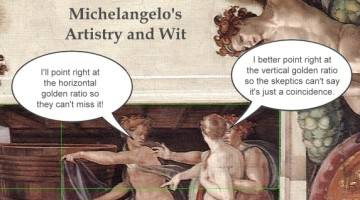2015 study announces the discovery of the Golden Ratio in the Sistene Chapel.
Clinical Anatomy
The excitement of the authors in making this discovery for themselves is understandable, and their creativity is commendable. The discovery though was not entirely new, and it does not appear to be entirely accurate, nor complete.
The Brazilian study though motivated me to take a deeper look at Michelangelo’s composition of his paintings in the Sistine Chapel. This led to much richer evidence yet of Michelangelo’s use of the golden ratio, also known as the Divine Proportion. These new findings are presented in a separate article, Michelangelo and the Art of the Golden Ratio in Design.
Analysis of the findings of the 2015 Brazilian study.
The authors of the Brazilian study stated,
while the beauty of Michelangelo’s works is indisputable, there is no information in the literature regarding any association between his works and the Golden Ratio. Thus, adopting a pioneering method, we decided to analyze one of Michelangelo’s most famous works (The Creation of Adam) painted on the ceiling of the Sistine Chapel to see if there is any relationship with the Golden Ratio.“
The study reported that:
- the fingers of God and Adam touch at the golden ratio of the width of the painting.
- the fingers touch at a point that is approximately at the golden ratio of the length of all the paintings on the ceiling of the Sistine Chapel.
Part of their “discovery” was presented here in 2013. Part of it was inaccurate.
The appearance of golden ratios in “The Creation of Adam” was published on this site in August 2013, as shown at https://www.goldennumber.net/art-composition-design/. In addition to the horizontal golden ratio they reported at the touch point between God and Adam based on their widths, my 2013 article also revealed a vertical golden ratio based on the height. This finding was contributed by reader Mikko Bojarsky. More evidence on this finding is presented below.
Their analysis of the golden ratio in the length of the Sistene Chapel’s ceiling took the analysis one step further than my 2013 article, but it turns out that it’s not very accurate. I used PhiMatrix to verify their analysis. PhiMatrix quickly and easily finds and applies golden ratios, or any custom ratio, and is accurate to the pixel. This revealed their finding of the golden ratio in length of the ceiling to be somewhat inaccurate.
Any good analysis on dimensions within a photograph requires that the image be as free as possible from optical distortion. The image selected by the Brazilian researchers for their analysis has a high degree of distortion, as shown by the curvature of the straight lines on the ceiling. Compare their image on top to the non-distorted image below it :
The Brazilian study shows that the proportions they found in the ceiling are closer to 1.6, as indicated by their annotation. The true golden ratio point is shown by the gold dividing line, slightly to its left. Click on the image for full resolution.
Let’s do a more precise analysis yet using the non-distorted image. This reveals that the golden ratio point of the entire width of the paintings is well to the left of the point reported in the Brazilian study, as shown below. The gold line shows the golden ratio from the outside edge of the paintings. The green line shows the golden ratio from the area of the ceiling that frames all the paintings. Click on image for high resolution.
The place at which the fingers actually touch is at a ratio of 1.68, based on the outside edge of the paintings. The touch point is 1.707, based on the area of the ceiling that frames all the paintings.
So, did Michelangelo intend this to represent a golden ratio? Possibly, but probably not with as much likelihood or precision as the Brazilian study suggests.
Background on the discovery announced in my 2013 article
Following is some detail on the background of the discovery of this information presented in 2013. The date on my original article on this topic shows as May 4, 2014. That is only because the entire GoldenNumber.net site was redesigned at that time using a new platform. The Archive.org Wayback Machine shows the original content on an archived version that page on August 8, 2013 at:
https://web.archive.org/web/20130813191911/https://www.goldennumber.net/art-composition-design/
Additionally, a Google search for “creation of adam golden ratio” in August 2015 revealed that Google already had my article and image as their top listing:
Click image for full resolution or see where it is at the current moment at https://www.google.com/?gws_rd=ssl#q=creation+of+adam+golden+ratio
This discovery was originally submitted to me on November 25, 2011 by Mikko Bojarsky, a GoldenNumber.net contributor. He used my free golden ratio template to make his finding, and sent this:
“Thought you might be interested in this application of your golden ratio ruler to Michelangelo’s Creation of Adam. Many thanks for inventing and distributing this helpful device.” Mikko Bojarsky
The golden ratio tends to be “discovered” again and again, by many individuals across history. It is entirely possible that these discoveries have been made before mine. This does not make them any less exciting or worth repeating. As with the discovery by the team in Brazil, this is often the way that our understandings grow deeper yet. I thank them for the initiative and creativity in their work, and for inspiring me to take the study further yet.
References:
http://www.scielo.br/scielo.php?script=sci_arttext&pid=S1677-55382012000300004
